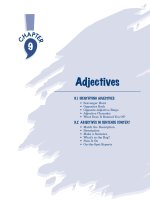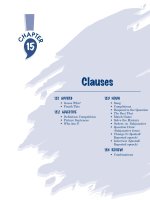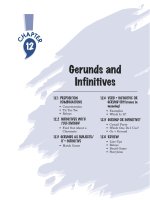fun With Grammar - Questions
Bạn đang xem bản rút gọn của tài liệu. Xem và tải ngay bản đầy đủ của tài liệu tại đây (343.24 KB, 23 trang )
Questions
5
5.1
YES/NO
QUESTIONS
• Short Answers 1
• Short Answers 2
• Are You the One?
• Human Bingo
• Twenty Questions 1
• Twenty Questions 2
5.2 INFORMATION QUESTIONS
• Board Game
• The Newlywed Game
• You’re the Reporter
• A Business for Your
Town
5.3 INFORMATION QUESTIONS
AND/OR
YES/NO
QUESTIONS
• Question Order
• What’s the Question 1?
• What’s the Question 2?
• Question and Answer
Practice
• Answering Ads
5.4 TAG QUESTIONS
• Tag Questions
105
These games and activities concentrate on the practice of question word order in
verb tenses. Although the worksheets may feature just one tense, you can adapt
them for other tenses, or as a review for all verb forms. See Chapters One and Two
for other games and/or activities that also use questions as part of the activity.
5.1
YES/NO
QUESTIONS
1. SHORT ANSWERS 1
Materials:
Worksheet 33A or 33B, or your
own strips with answers
Dynamic:
Pairs/Small groups
Time:
15 minutes
Procedure:
1. Arrange students in pairs or groups of three or four. Give each
group a strip with short answers on them. Have the students work
together to write questions for the answers.
NOTE: If you are using a worksheet, choose the one appropriate to
your level. Preferably, use the worksheets as models for making your
own.
2. Have each group read the questions and answers aloud and let the
rest of the group judge whether the questions are appropriate.
2. SHORT ANSWERS 2
Materials:
None
Dynamic:
Pairs/Small groups
Time:
25 minutes
Procedure:
1. Divide the class into pairs or groups of three or four. Have each
group write five short answers on a piece of paper. You can either
limit the answers to certain verb tenses or let students use any
tense for review.
2. Each group exchanges papers with another group. Each group then
creates questions for the answers provided by the other group.
3. Return the papers to their originators and have the group or pair
that created the answers now check that the questions written by
the other group or pair are good matches for their answers.
3. ARE YOU THE ONE?
Materials:
Worksheet 34A or 34B
Dynamic:
Whole class
Time:
20 minutes
Procedure:
1. Distribute a copy of the worksheet to each student. Tell them to
circulate, asking questions as in the model for each of the phrases.
Example: Worksheet: plays volleyball
Student A: Do you play volleyball?
Student B: Yes, I do.
2. When another student responds yes, the student asking the
question writes the responding student’s name on the blank. If the
student answers no, the questioner continues until he/she finds
someone who answers yes.
3. When a student completes the worksheet, he/she sits down, but
should be prepared to answer other students’ questions.
4. Go over as many of the questions/answers as time allows.
NOTE: You can limit answers to only one yes answer per student.
This avoids students pairing up and just talking to one or two
other students. Or you may want to allow students to write a
classmate’s name as many times as that student answers yes.
4. HUMAN BINGO
Materials:
Worksheet 35A
Dynamic:
Whole class
Time:
20 minutes
NOTE: Worksheet 35A contains some items in the present perfect, so
it should be used only with intermediate/advanced classes. By
adapting the worksheet to eliminate the present perfect, you can use
this game in beginning classes. Use the blank Worksheet 35B to
create your own game. At the higher levels especially, you may want
to use the blank to create a game that is more interesting for your
students by using “real” information about them.
Procedure:
1. Copy a handout for each student. Worksheet 35A is for reviewing
all verb forms. To limit this activity to one verb tense, reword the
phrases so that the questions are in that tense and use Worksheet
35B.
106
107
2. Review question formation, if necessary, so the students are able to
form questions from the prompts.
3. Tell students to circulate, asking their classmates questions as
indicated by the prompts. If a student answers yes, the student
asking the question writes that student’s name after the prompt.
If the student answers no, the questioner continues asking until
he/she finds someone who answers yes.
4. As in Bingo, there are several ways to win.
a. The first student who gets five names in a row wins.
b. The first student who fills in the four corners wins.
c. The first student who completes the board wins.
d. The first student who makes a cross wins (third row down and
third row across).
e. Use any other variation you choose.
5. After a winner is found, go over the tense used and why (could be
fact or habit) and some of the answers (“Who speaks Spanish?”
“Who has more than one pet?”).
SUGGESTION: This is a great game to play at any holiday time. Fill
in the blank worksheet with prompts related to the holiday and
whatever tense you’re working on at the time.
5. TWENTY QUESTIONS 1
Materials:
None
Dynamic:
Whole class
Time:
10 minutes
Procedure:
1. Choose a category (famous people, occupations, food, animals, etc.)
2. Choose one student to answer questions from the rest of the class.
Show the student a word on a piece of paper (what he or she is).
The word should be an object or person. Have this student sit in
front of the class. Instruct this student to answer only yes or no to
any question asked of him/her.
3. Instruct the class to ask only yes/no questions. Their purpose is to
discover the identity of the student in front of the class. The class
is allowed only 20 questions. If they can guess the student’s
identity before or by the twentieth question, the class wins. If they
do not guess correctly, the student wins. (Although this is based on
the popular “Twenty Questions” game, you may want to actually
vary the number of questions the class can ask. Be sure to make
the number clear before the activity begins.)
Variation:
To make the game more challenging, especially at the higher levels,
you may want to omit step 1 so that the students use up some of their
questions determining the category.
6. TWENTY QUESTIONS 2
Materials:
Small pictures
Dynamic:
Whole class
Time:
15 minutes
Procedure:
1. Tape a small picture on the back of each student, staying within
the same category (movie stars, politicians, animals, professions,
etc.).
2. The students circulate and ask each other yes/no questions to
discover “who” or “what” they are. The responding students look at
the picture on the back of the questioners before answering.
Circulate around the class to help out if the students are not sure
of the answer. Instruct the students that they can answer “I don’t
know” if they are unsure and you are not available to ask. In the
example below, the first two questions can be answered with yes or
no just by looking at the picture. The other two require that the
student being questioned know the identity of the person in the
picture. The following questions could be used with a famous-
person picture:
Examples: Am I a woman?
Do I have blond hair?
Did I win an award?
Have I been in more than one movie this year?
If using a different category such as professions, the following type
of questions may be asked:
Do I work in a hospital?
Am I wearing a uniform?
Do I work in an office?
3. For a competition, the first student to discover his/her identity
wins. If it is not a competition, set a time limit and try to have as
many students discover their identities as possible. When a
student discovers his/her identity, be sure that he/she continues
to answer questions for those students who are still guessing.
108
109
5.2 INFORMATION QUESTIONS
1. BOARD GAME
Materials:
Worksheet 36
One die per group, one marker for each student
Dynamic:
Groups
Time:
20 minutes
Procedure:
1. Divide the class into groups of four. Give each group one die, one
game board, and a marker for each student in the group.
2. The students roll the die and move around the game board by
making questions for the answers on the board. The other
students in the group judge whether the questions are appropriate
and grammatically correct. Be sure to circulate to settle any
disputes or questions that arise.
3. The first student in each group who reaches the end is the winner.
2. THE NEWLYWED GAME
Materials:
4 or 5 large pieces of paper for each student volunteer
Dynamic:
Whole class
Time:
40 minutes
Procedure:
1. Ask for volunteers or nominations from the class to form four sets
of “newlyweds.” There will be four “husbands” and four “wives.”
Choose a theme, such as food, work, weekends, or relatives, to give
the couples a focus in preparing their “marriage.”
2. If your theme is food, tell the “husbands” that you are going to ask
them questions about the eating habits of their “wives.” Then send
each “husband” and “wife” pair to a different part of the room to
exchange information. Stress that only the “husband” needs to get
information from the wife at this stage. The “wife” doesn’t need to
know about the eating habits of the “husband.”
3. Have the remaining students come up with a list of questions
(based on the theme) that will be directed to the “husbands.”
Possible questions:
What does your wife put in her coffee?
What is her favorite fruit?
What food does your wife hate?
Where does she like to go for dinner?
How does she like her eggs/steak cooked?
If there is time, have the class think of a prize, such as an all-
expenses-paid week in Hawaii.
5. When you have four or five questions and the “husbands” have had
about 10 minutes to get the necessary information, recombine.
Have the “husbands” and “wives” sit on opposite sides of the room,
facing each other. Write the couples’ names on the board and ask
for a volunteer scorekeeper. Have another volunteer be the
announcer; give the announcer the questions.
6. The announcer reads the questions slowly and carefully to the
couples. Both “husbands” and “wives” write down their answers.
(Other students watch to make sure there is no eye-contact or
hand signals between them.)
7. When all the questions have been asked and the answers written,
the announcer reads the questions again, but this time the couples
show what they have written. The scorekeeper gives points if the
answers match. The winning couple gets the prize.
8. Switch roles. Choose a new theme and have the “wives” get
information from the “husbands.” Repeat the steps. (At this point,
you may want to choose new “couples.”)
3. YOU’RE THE REPORTER
Materials:
One newspaper article for each student
Dynamic:
Pairs
Time:
40 minutes
Procedure:
1. Either provide a newspaper article for each student, or ask
students to bring one to class (a previous night’s homework
assignment). If you have time, distribute old news magazines
which students can use to find articles. You may want to suggest
an approximate size for these articles.
2. Have students read the article and write five to eight Wh-
questions based on it.
3. Divide the class into pairs. Have the partners check each other’s
questions for grammatical accuracy. Then the partners trade
articles and answer the questions by reviewing the material in the
news articles.
110
111
4. A BUSINESS FOR YOUR TOWN
Materials:
Pencils and paper
Dynamic:
Groups
Time:
45 minutes
Procedure:
1. Discuss with the class what types of businesses there are in your
area and what types of businesses students might like to set up.
2. Divide the class into groups of approximately four. Tell the groups
that they are going to research and design a new business for their
town. To determine whether the business will be successful, they
must design a simple survey (5–10 questions) that will give them
the necessary information about the kind of business that they
choose to set up.
3. Help the students come up with Wh- questions for their survey.
The following questions could be used for a shoe store.
What kind of shoes do you wear?
How many pairs of shoes do you have?
How much do you spend on a pair of shoes (on average)?
What color shoes do you like?
Where do you buy your shoes?
How many people are there in your family?
4. Students should write simple questionnaires and make copies for
each group member. (You may need to do this.) Each member
should do at least five interviews with people in the community.
(You may want to assign this step for homework.)
5. After interviewing community members, students regroup and
compare results. Results can be compiled in the form of a bar
graph. They can then make an educated decision about whether
the “business” will fail or succeed. The groups then present their
results to the class in a mini-presentation.
5.3 INFORMATION QUESTIONS AND/OR
YES/NO
QUESTIONS
1. QUESTION ORDER
Materials:
Cards or strips of paper
Dynamic:
Groups
Time:
10 minutes
Procedure:
1. Prepare a list of questions for this activity. Make questions with
enough words so that each student will have one card.
Example: Where has he already traveled?
Cards or strips:
2. Arrange students in groups corresponding to the number of words
in each question. Give each group one cut-up question.
3. Have the group put the words into correct question order. When
they have finished, call each group to the front of the class and
have the students stand in order, holding the cards. (If a student is
absent on the day of this activity and you have an extra card,
simply have a student hold up two cards.) The rest of the class
judges if the order is correct.
NOTE: This activity can be used at any level. Just prepare questions
that cover the tenses/structures that you want to review. If you want
to use punctuation, include that on a card also.
2. WHAT’S THE QUESTION 1?
Materials:
Board
Dynamic:
Small groups
Time:
20 minutes
Procedure:
1. Write a list of answers about yourself on the board. Divide the
class into groups of approximately three. Students are to write
logical and grammatical questions that correspond to your
answers. Accept any question that fits the answer. For example, if
you write “1995” on the board, you would have to accept questions
Where has he already traveled
112









